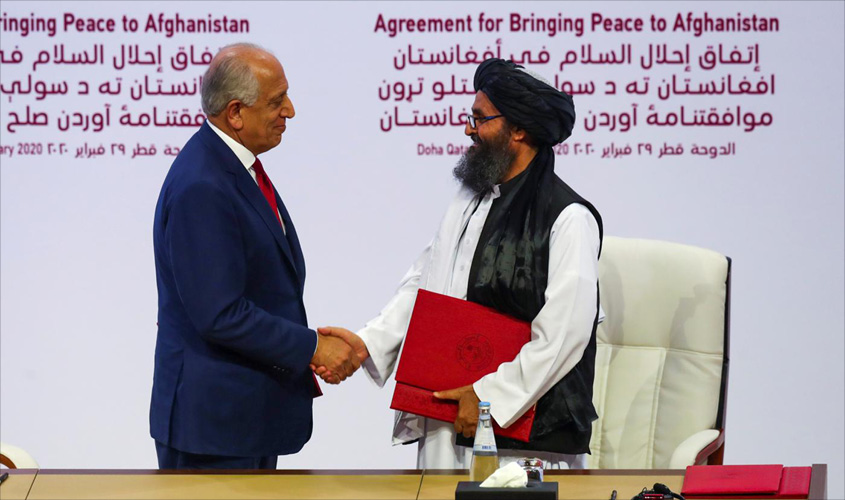The US-Taliban agreement inked last year on 29 February 2020 after exhausting rounds of complex negotiations engaging the Taliban and the US representatives paved an exit plan for the US and foreign forces from Afghanistan by 1 May 2021. Needless to say, given the historical evidence, the agreement aimed at ensuring rather unrealistic guarantees from the Taliban to curtail their ties with extremist individuals/groups including Al Qaeda, and not allow Afghan territory to be a haven for Al Qaeda and other such groups/individuals. The agreement, from day one, brooked strong apprehensions regarding its adverse impact on the security situation in Afghanistan and also its potential to further strengthen Taliban’s conviction regarding their ability to push their terms and conditions with the United States and the democratically elected Afghan regime under President Ghani.
The signing of the agreement was supposed to be followed by the intra-Afghan talks. President Ghani, despite enormous resistance, was compelled to agree to the Taliban’s condition of release of 5,000 Taliban prisoners as a pre-requisite for the intra-Afghan talks. Many of the released Taliban prisoners have reportedly joined the fighting in Afghanistan adding to the severity of the security dynamics.
Official reports suggest that the total number of foreign troops in Afghanistan is around 9,600 including 2,500 US troops. The Taliban have been rejoicing the signing of the agreement as a well-known Afghan proverb, “You have the watches, but we have the time”, is finally about to become a reality in Taliban’s view (and multiple other non-state actors in Afghanistan) who have been fervently anticipating the departure of the foreign forces from the country. Taliban never agreed to the ceasefire, thus violence is spiking in Afghanistan and the nature of the attacks has turned gruesome with “targeted assassinations”, which has added to pessimism regarding the future of Afghanistan. Middle-class professionals including journalists, police, prosecutors, and judges
The regional branch of the Islamic State group—Islamic State-Khorasan (IS-K)—seems to have gathered strength and is keen to make its presence felt in Afghanistan. According to intelligence services, the estimated capacity of the militant group is between 1,000-2,500, which is sufficient to conduct high-profile attacks in cities of Afghanistan.
The stalled intra-Afghan talks do not promise a political solution anytime soon. The Taliban, on 7 February, announced on their official website that the Ghani government “lacks all domestic and international legitimacy and must be replaced with an Islamic government…declaration of Islamic Emirate…” The areas under the Taliban control reportedly follow a rigid and forceful interpretation of the Sharia law. And the Taliban have made it very clear that nothing less than an Islamic Emirate will be acceptable to the group.
Repeated official revelations by US intelligence agencies have failed to impact the existing ties between the Taliban and Al Qaeda. The 4 January 2021 summary of the US Department of Treasury stated, “Al Qaeda is gaining strength in Afghanistan while continuing to operate with the Taliban under the Taliban’s protection… Al Qaeda capitalizes on its relationship with the Taliban through its network of mentors and advisers who are embedded with the Taliban, providing advice, guidance, and financial support.”
The Taliban are trying hard to strengthen their relationship and a support base amongst the regional powers—Pakistan, Russia, Iran, and Central Asia. Pakistan remains strategically aligned with the Taliban and Mullah Abdul Ghani Baradar led a Taliban delegation to Pakistan on 16 December 2020. The group visited Iran on 26 January on a formal invitation for a bilateral meeting “to review (the) Afghan peace process”. The Taliban delegation met Zamir Kabulov, Vladimir Putin’s special envoy for Afghanistan, during the Moscow visit in January to ensure Russia’s support to the exit of the US troops. On 6 February, the Taliban’s visit to Turkmenistan was reported to have discussed the construction of the Turkmenistan-Afghanistan-Pakistan-India (TAPI) natural-gas pipeline and the Turkmenistan-Afghanistan-Pakistan (TAP) power line (according to the Turkmen foreign ministry).
Although the Taliban has been actively trying to reaffirm its legitimacy and strengthen its relationship with major regional powers, the Biden administration is inclining towards reviewing its Afghan policy and decision of withdrawal of the forces. The US needs to seriously examine the option of a condition-based approach in Afghanistan to be able to ensure that the country doesn’t slide into complete chaos and a civil-war-like situation.
Dr Shalini Chawla, Distinguished Fellow, Centre for Air Power Studies, New Delhi.
One year of the US-Taliban agreement: Where does Afghanistan stand?
इस शब्द का अर्थ जानिये
- Advertisement -

